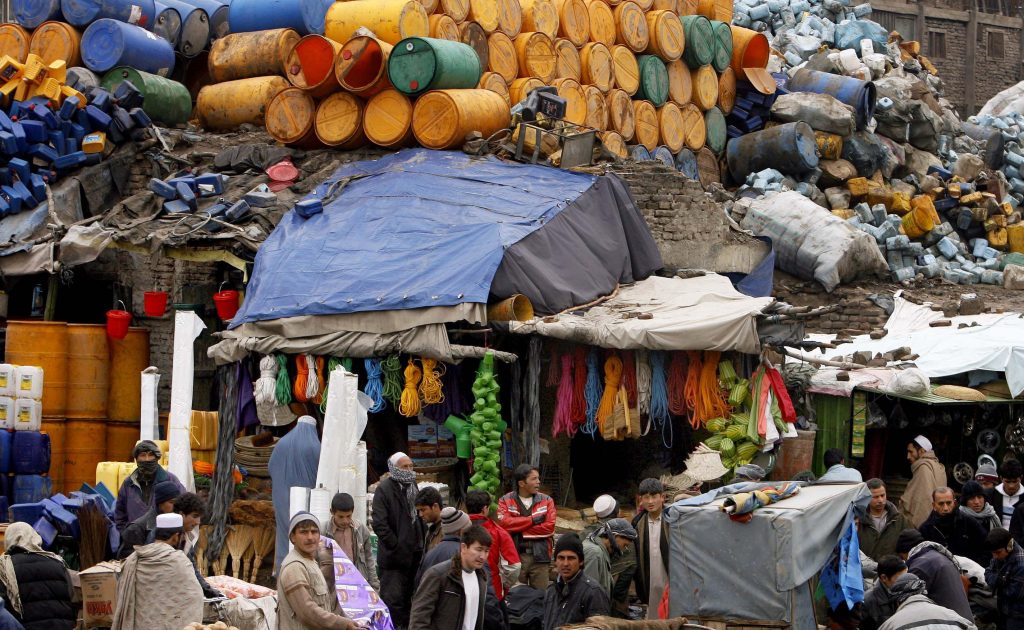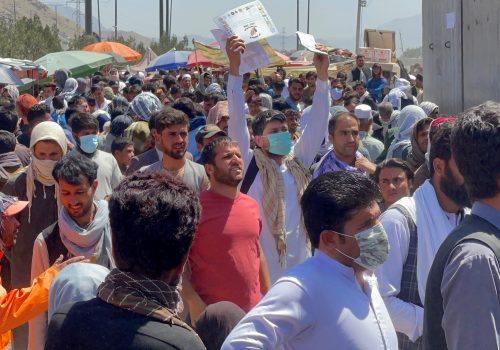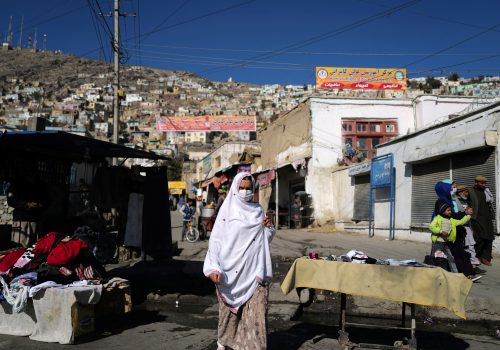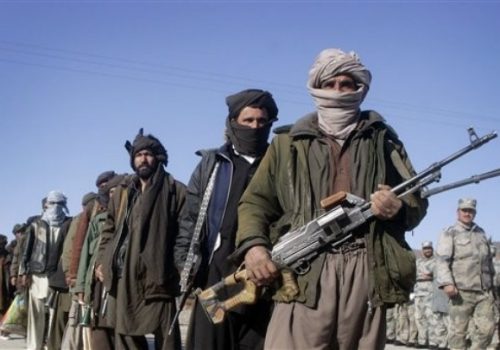The Biden administration’s General License (GL), announced in February 2022 and exempting international commercial transactions from US sanctions, is a step in the right direction, but its effects will prove limited as it will not solve the immediate need for liquidity, currency stability, and purchasing power.
As welcome as the move is, a number of sanctions-related obstacles to restarting the Afghan economy remain. First, the Biden administration’s widely misunderstood executive order blocking Afghanistan’s foreign reserves leaves the country’s central bank unable to perform its critical macroeconomic management functions. Second, the ongoing lack of a willing international correspondent (i.e., intermediary) bank means that Afghan businesses remain unable to conduct financial transactions with the outside world. Third, the GL’s cautionary language such as “to the extent authorization is required” and the “self-executing” mechanism (i.e., businesses have to guess whether sanctions apply to them) does little to reduce fears of inadvertently violating US Treasury sanctions. Finally, without resolution of these obstacles, any transactions through existing channels are likely to remain expensive and onerous.
Still, these recent moves may have a signaling effect in getting the World Bank, the International Monetary Fund (IMF), and the US government itself to pick up the pace of their activity. The international community can take advantage of the upcoming UK-sponsored humanitarian pledging conference by expanding it to include economic and development support. United Nations (UN) Special Representative for Afghanistan Deborah Lyons recently noted that while we may have “averted our worst fears of famine and widespread starvation,” this serves “only to buy a little time,“ and that “it is imperative that we not find ourselves six months from now in the situation we faced six months ago: with millions of Afghans facing another winter of starvation and the only tool at our disposal being expensive and unsustainable humanitarian handouts.”
Challenges beyond sanctions
Beyond the humanitarian crisis and sanctions related obstacles are questions about the prospects for the Afghan economy under Taliban governance. Despite the almost limitless resources that poured into the country during the last twenty years, growth was constrained by risk and uncertainty from the political climate, violence and physical insecurity, poor business enabling environment (e.g., corruption and patronage), weak physical and institutional infrastructure, and self-interested policies of regional neighbors. Now, in the wake of their hostile takeover of the state, the Taliban must wrestle with those challenges as well as some additional ones caused by their own lack of capacity and antagonistic relations with broad swathes of the population–and with, at best, a fraction of the resources.
With estimates that post-August 2021 job losses may soon exceed 900,000 and unemployment may nearly double in the next two years, these challenges start with creating jobs. Adding to the already unemployed, a reported 1.2 million Afghans returned from Iran either voluntarily or forcibly during 2021 (486,000 from August). A special category of jobless is the estimated 85,000 Taliban fighters and the over 300,000 former Afghan National Defense and Security Forces members, as well as numerous local militias, most of whom are now unemployed and need to transition into civilian occupations.
Primarily due to lack of employment opportunities, every day an estimated 3,000 Afghans (primarily male) depart legally for Iran, with an additional 3,000 smuggled illegally through Nimroz province alone. Many are set on reaching a Europe that is now struggling with a new refugee crisis without any foreseeable end. The UN and non-governmental organizations have initiated cash and food for work programs, but until the economy can be revived, they will have limited effect.
Opportunities for the economy
Looking at the half-filled glass with the country–albeit uneasily–at peace, insecurity is no longer the primary obstacle. There are no mysteries as to the economic opportunities available to Afghanistan. A vast library of policy papers and studies (some going back decades) have identified agriculture and agribusiness, regional trade and transport, and mining/extractives as areas for growth. Indeed, initial statements from various Taliban-headed ministries have reaffirmed these as priorities.
The Taliban have given a high priority to regional and cross-border trade, and have announced their intention to continue with several long stalled regional projects, including the Turkmenistan-Afghanistan-Pakistan-India (TAPI) gas pipeline first initiated in 1995. Since their takeover, the Taliban have predictably moved closer economically to their patron Pakistan, something that is viewed with unease by many Afghans due to longstanding suspicions of Pakistani motives. The recent headline “Pakistan eases import process for Afghan traders” could have been written at almost any time in the last 75 years. It thus remains to be seen whether the Taliban’s client relationship with Pakistan will mitigate the long standing bilateral transit issues that have hampered trade with Afghanistan’s external markets, especially India, or whether disagreements over the presence of the Tehreek-i-Taliban Pakistan and other issues will simply provide a new set of mutual irritants.
Motivated primarily by the desire for regional stability and the opportunity to gain control over mineral resources, China has expressed interest in mineral investments, including reviving the Aynak copper mine and other projects that have been on hold due to insecurity. There has also been speculation about the possible extension of the Belt and Road Initiative and China-Pakistan Economic Corridor, but the likelihood of substantial investments or spending seems low. In any case, China is unlikely to provide an alternative to US and western funding. Moreover, given China’s global history of unfavorable commercial and financial agreements, Chinese involvement would be a potential source of both opportunity and risk for Afghanistan.
Economic management and governance
At the top of Afghanistan’s list of challenges is economic management and governance. During the Taliban’s 1996-2001 rule, to the extent that they had an economic policy at all, they were generally pro-commerce, given their trader constituency and 1994 origin story about putting a decisive end to the predatory taxation by warlords that was throttling commerce. During the insurgency, they were more attentive to the economy, given the imperative to obtain tax revenues and to cast themselves as a legitimate authority capable of administering a state.
Since taking power seven months ago, they have announced some unproductive policies (e.g., banning foreign currency transactions, restricting women’s employment, etc), but have also said some of the right things. At the Afghan Ministry of Finance’s program “Afghanistan Economic Conference: New Beginning” on January 19, 2022, references were made to the market economy as the main driver of growth and development; the need to create a positive enabling environment and remove obstacles to trade and investment; and the importance of agriculture, mining, and regional trade. These ideals would not have been out of place at an event held by the former Afghan republic or even a US Agency for International Development sponsored event on private sector development.
It is unclear to what extent the Taliban have expanded parts of their worldview during their extended time in Pakistan and Doha, or whether this is the voice of some remaining Republic-era technocrats who may or may not speak for the leadership. The Taliban claim to have collected $400 million in revenue during the last three months of 2021, which suggests that collection at border crossings was indeed more effective (i.e., less corrupt) than under the Republic, produced a reasonably credible three-month national budget that draws only on domestic resources, and reduced administrative corruption. Simply by formulating the budget, the Taliban have already improved on their previous time in power.
What should be done
To have any hope of allowing the private sector to restart, the Taliban must take on economic governance in the following four interrelated areas:
- Establish a rules-based order: While the Taliban have so far left in place the legal frameworks remaining from the Republic, at some point they may decide to put their own stamp on certain laws, according to their own view of what Islam requires. The resulting laws may be at odds with international practices and Afghanistan’s experience. Moreover, recalling how contested the development of mineral and commercial laws were, this could produce a long, drawn-out process. As was observed under the Republic, “unclear and conflicting laws and regulations, as well as undefined roles for various government institutions, increase the opportunity for corruption and rent seeking.” Uncertainty created by such a process would push even more of the economy into the informal sector and into illicit activities–a recurring and harmful theme in Afghanistan’s history.
- Limit corruption: Anti-corruption–both financial and moral–is the Taliban’s claimed brand, and their officials have argued that administrative corruption, extortion, kidnappings, and usurping of funds have all been eliminated. At a February conference, Deputy Prime Minister Mullah Abdul Ghani Baradar attributed Afghanistan’s lack of self-sufficiency to much of international funding over the last twenty years having gone into officials’ pockets. As willing as many in the Afghan business community have been to initially give the Taliban the benefit of the doubt on corruption, public opinion is fickle, and there are already credible reports of bribe-taking and other illicit activities. Just as there were limits to how hard Republic officials were willing to push on corruption, it may be difficult for Taliban leadership to put limits on lower-level officials, especially in far-flung areas and given the fear that too much pressure could lead to defections to the Islamic State Khorasan Province (IS-K). During the insurgency, local commanders were generally allowed to retain revenue collected beyond the portion they submitted to the central treasury. It is easy to see conflicts arising from Kabul’s attempts to enforce national policies, obtain revenues collected locally, and manage former commanders, many of whom are now local officials reluctant to cede control over taxation/extortion. Naturally, the most likely source of tension would be the lucrative drug economy.
- Establish administrative coherence: To encourage any substantial level of investment, expansion, and innovation, the Taliban will have to avoid the type of chaotic administration that characterized their 1996-2001 rule, which was marked by inconsistent and confusing edicts issued by competing power centers. Without coming from a definitive and competent source, edicts are likely to be ignored or avoided through bribery. Recent edicts banning hawalas (a widespread informal mechanism for transferring money), use of foreign currency, and harvesting of ephedra (used in production of methamphetamine) are examples of Taliban-led institutions announcing policies that either have to be walked back or are not enforceable.
It is understandable for government officials to equate highly concentrated authority with a functional administration. This is partly a legacy of memories of the way Afghanistan was administered before 1978, the last time the country was at peace. This view prevailed in 2002 at the start of the Republic period, when suggestions for decentralizing or deconcentrating authority were met with the position that decentralization would be considered only after the reestablishment of a competent central administration. The business community suffered the effects of over-centralization especially during the last years of the Ghani administration. Having a reasonable level of deconcentration is especially important given the lack of experience of many Taliban officials and the hierarchical nature of their movement. This is not an argument for federalism or regional warlordism, only for reducing the time businesses have to spend on bended knee in Kabul.
- Strengthen and maintain key institutions: Taliban leadership appears to recognize the importance of the Ministry of Finance and the central bank, (Da Afghanistan Bank, or DAB), and has so far kept on a number of technical staff. DAB is statutorily independent, and the Taliban could build confidence by appointing a technocratic, clearly independent, and non-political head, while ensuring technical capacity to monitor use of funds. International community objections to releasing the assets are partly due to reluctance to put them in the hands of untrained or political persons, concerns which are shared even by many Afghans who support the release of those funds. Unfortunately, the recent appointment of a senior Taliban military leader said to have managed funding for bombmaking did little to build confidence. Having an unassailable governor and proper guardrails would help undermine some of the arguments against releasing the funds. The Taliban should also try to retain the class of educated and experienced administrators, managers, and entrepreneurs who represent human capital that is badly needed to administer the state and drive the private economy, many of whom have already fled the country or confined themselves to their homes because they fear for their safety or consider life under Taliban rule unviable.
The use of a World Bank and UN-managed process to distribute humanitarian assistance and the proposals to put foreign reserves in the hands of a non-governmental entity have generated a lively discussion about accountability and overhead costs. Discounting some of the polarized political statements, more and more Afghans have been raising legitimate concerns about the costs, overheads, and accountability of any parallel system. Building independence and transparency in key Afghan institutions would remove one of the main arguments about allowing them to control resources. (It should be remembered that many Afghans also had similar qualms about putting money into the hands of Republic officials.) As one expert noted, “making Afghan budgetary expenditures accessible for analysis along with revenues and fiscal balances would concretely demonstrate effective governance and macroeconomic management by the Taliban government.”
Policies towards women and girls
Emerging Taliban policies on women and girls are being contested in the push and pull of public demonstrations in the cities and through international pressure. Even if not as onerous as during 1996-2001, any restrictions on mobility, education, and employment are unacceptable to a society in which women have participated more fully in the last twenty years–illustrated by the widespread fierce reaction to the recent last-minute decision to ban girls from attending secondary schools. Women’s participation has an economic and poverty reduction imperative as well; the UN Development Programme recently estimated that restrictions on women’s employment could immediately cost the Afghan economy one billion dollars, resulting in its Gross Domestic Product (GDP) dropping by a further 5 percent. Many consider policies such as requiring a mahram (male family member escort) both unacceptable and impractical, especially for the many households that cannot get by only on the earnings of male members or where women are the sole providers.
Although interpretation and enforcement of laws and edicts will inevitably vary by regional and locality, this issue is unlikely to be resolved in a way that is satisfactory to all parties. Taliban leaders are unlikely to relent on conservative policies regarding women in the formal workplace, apart from certain health and education jobs under heavily circumscribed conditions. Given the professed red lines among donor nations, this has implications for international engagement as well.
Engagement with the international community
Last but certainly not least, the Taliban and the international community are warily working out their new relationships, with domestic political considerations a factor on all sides. Even before the Taliban takeover, after twenty often-contentious years, relationships between Afghans and the international community were frayed. Now they are even more frayed due to a whole set of issues, including rights of women and girls, human rights, inclusive government, free movement of citizens, sanctions, frozen assets, and lingering resentments from–depending on the perspective–the conduct of the war and its ending in a chaotic withdrawal and perceived US betrayal. The recent decision on girls’ secondary schools underlined the gulf between the Taliban leadership and much of the world on what constitutes acceptable social norms. It is hard to see how the Taliban could deliver the concessions demanded by the international community in exchange for diplomatic recognition without alienating a significant part of its base–and providing a recruiting opportunity for IS-K. Lobbying by some regional countries notwithstanding, this suggests that official recognition is far into the future.
Regardless, there are no conceivable scenarios under which Afghanistan will receive anywhere near the level of financial and technical support it received during the last twenty years, even if, contrary to their public statements, the Taliban were willing to accept it. Other world crises, not least the current situation in Ukraine, will place a call on political attention and financial resources.
Both sides have an interest in avoiding further economic collapse that would lead to instability and resumption of armed conflict, precipitate even more out-migration, and perpetuate Afghans’ suffering. The Taliban have the motivation to get the economy going for a number of reasons, including to show that they can manage the state and to avoid the type of conflict that will inevitably arise if Afghanistan’s citizens cannot achieve a minimum standard of living. The United States and the West more broadly have an interest in a functioning Afghan economy, in part because of their strategic interest in a stable Afghanistan that doesn’t export terrorism and generate even larger numbers of migrants to Europe, but also to refute the accusation that they are choking Afghanistan’s economy out of wounded pride at having been militarily defeated.
A modus vivendi would require each side to strategically avoid the type of unnecessary irritants that regularly popped up in the 1990s and that would give Washington and others reasons to maintain restrictions. For example, the Taliban’s recent announcements that Afghans formerly employed by NATO will not be allowed to leave the country and that women will not be allowed to travel outside of Afghanistan without a mahram can only be unwelcome distractions.
Given this common interest, the Biden administration should take more concerted and proactive measures, taking advantage of but not waiting for the March 31, 2022 pledging conference, to help the Afghan people restart their economy. This would help make the recent positive but inadequate measures true game changers as opposed to just running out the clock.
Paul Fishstein is currently a non-resident fellow at New York University Center on International Cooperation.
Murtaza E. Amiryar is Managing Director at Pearl Horizon Consulting Services LLC, an international development firm.

The South Asia Center is the hub for the Atlantic Council’s analysis of the political, social, geographical, and cultural diversity of the region. At the intersection of South Asia and its geopolitics, SAC cultivates dialogue to shape policy and forge ties between the region and the global community.
Related content
Image: Daily life around Afghanistan moves forward as U.S.Army Soldiers of the 2nd Battalion 19th Special Forces Group of the W.Va, Army National Guard conduct missions around the country in support of Operation Enduring Freedom XIII. Released.



